How to clean up battery acid leakage
We will learn how to distinguish between different battery types and how to clean up acid leakage from them.
Quick Guide
| Type of battery | Chemical for cleaning | Common places | Common Voltage value(s) | Multiplier | Note |
|---|---|---|---|---|---|
| Alkaline | Vinegar | Consumer products, toys etc. | 1.5V, 9.0V | 1.5 | More tend to leak than other types |
| Silver oxid | Vinegar | Watches, toys | 1.55V | Can contain mercury | |
| Lithium | Water | Cellphones, laptops, computers | 3.0V | 3-3.7 | Highly flammable, consider to dispose the device |
| Nickel cadmium | Baking soda | Rechargeable batteries for consumer products and toys | 1.2V | 1.2 | Highly corrosive |
| Lead acid | Baking soda | Industry, cars | 12V | 2 | Highly corrosive |
Background
This remote controller is used for the beamer screen in one of our meeting rooms at my job:
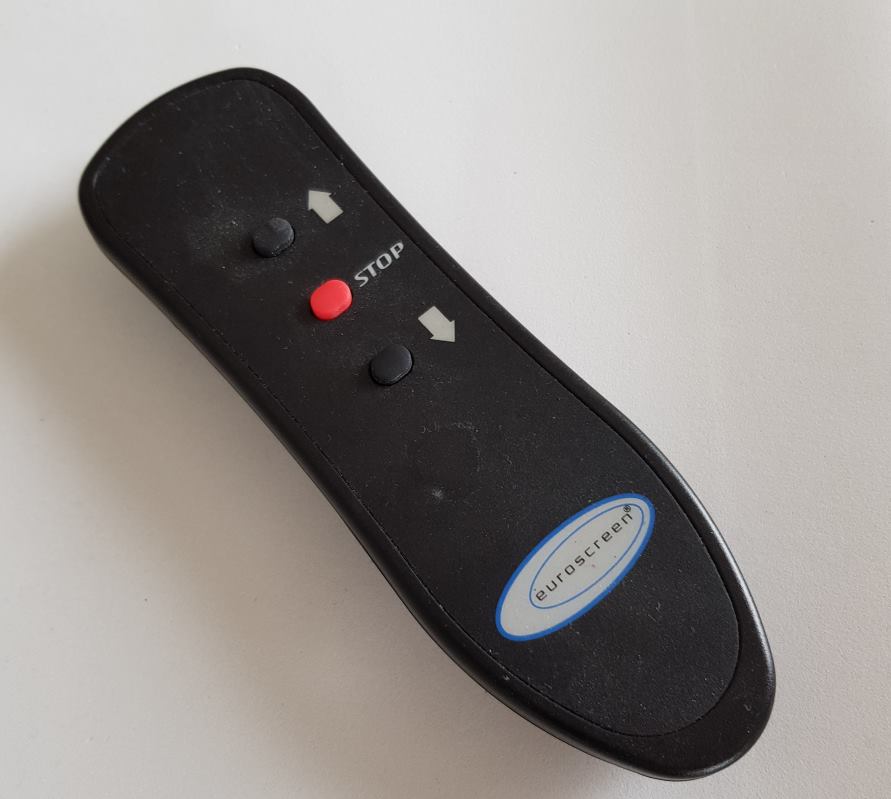
One day I wanted to adjust the screen, but it wouldn’t move. My guess was that the battery in the controller was dead. I opened the plastic lid on the back to replace them, but this was what I saw:
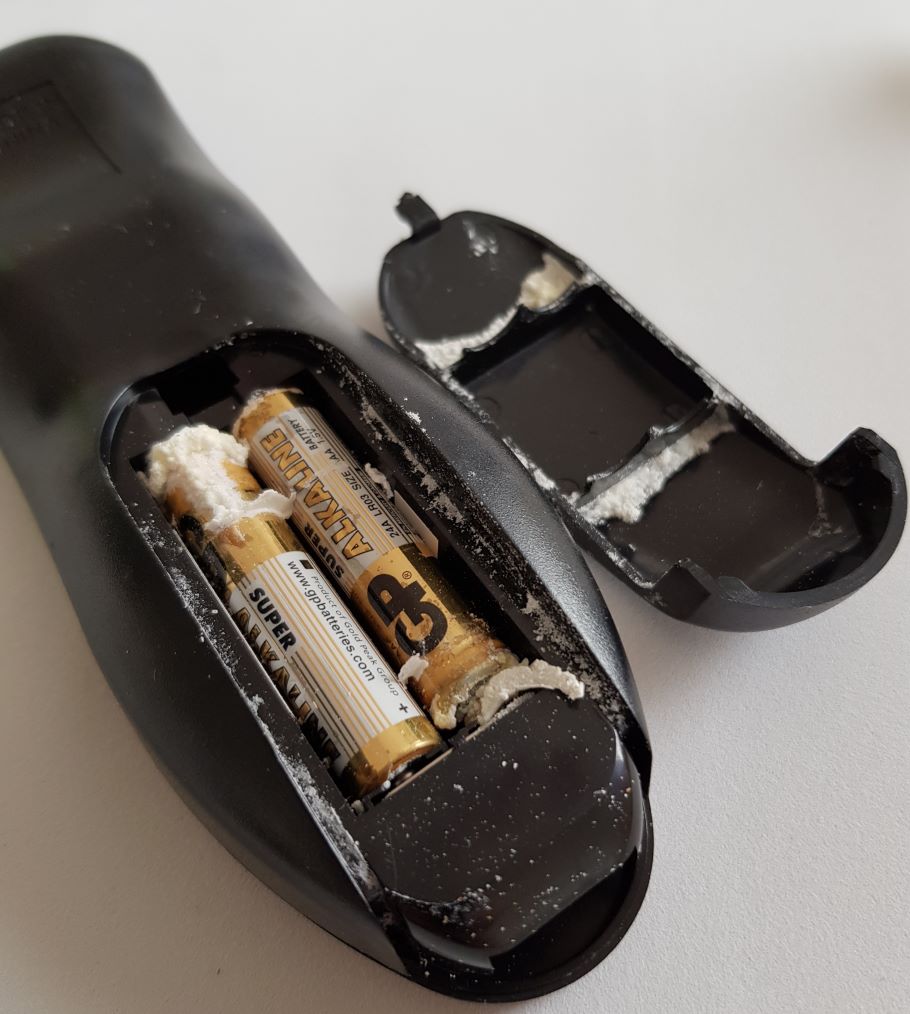
This was one of the worst battery acid leakage I have ever seen.
I must say that I was surprised by the reaction of my two colleagues in the same room. They had never seen battery acid leakage! They asked me: “What is that!?” “Is it broken?”. Well, I grew up with toys that consumed a lot of batteries. I had my share of battery acid leakage: in my remote-controlled car, in my remote controller for the NES and in my Game Boy. So, for me this was nothing new, but I learned that there are people out there that don’t know what battery acid is. In this blog I will answer my colleagues’ questions, and I can tell you already now that it is not broken! This post will teach you how to clean up the mess. And hopefully you won’t throw any electronic devices away unnecessarily.
Introduction
Alkaline batteries tend to leak. And they are very common in electronic consumer products. If batteries are left in a product unused, they will eventually leak acid. (I have noticed that if you mix same type of batteries but from different manufacturers the batteries will leak quiet soon.) Inside the batteries there is something like a small tank for battery acid. The acid is necessary for the chemical reaction inside batteries that produces electricity. The acid is supposed to never get out of there. But with time the chemicals inside the battery will produce a gas. When the pressure of this gas becomes too high it will destroy the tank and the acid will leak out. Once the acid is out it will start another chemical process with the new chemicals around it. The result of that is what you see on the picture above.
So, if you are not planning to use an electronic device on battery power for a while, then ALWAYS remove the batteries to avoid battery leakage!
Safety and cleaning
Note! Battery acid is dangerous. You should avoid getting in direct contact with it. When you clean make sure you use latex gloves and protection glasses. You should also use ventilation that blows away from your face. If you get in contact with battery acid, then use a dry brush to brush it away and later clean your skin with water and soap. The battery acid can cause bad irritation on the skin.
Alkaline batteries are not that dangerous, but it is good to be safe. Other types of battery leakage can be more dangerous. Lithium batteries can catch fire, silver oxide batteries can contain mercury, car batteries contain lead. Make it a rule of thumb that all batteries contain dangerous chemicals!
This is how my setup for cleaning looks like:
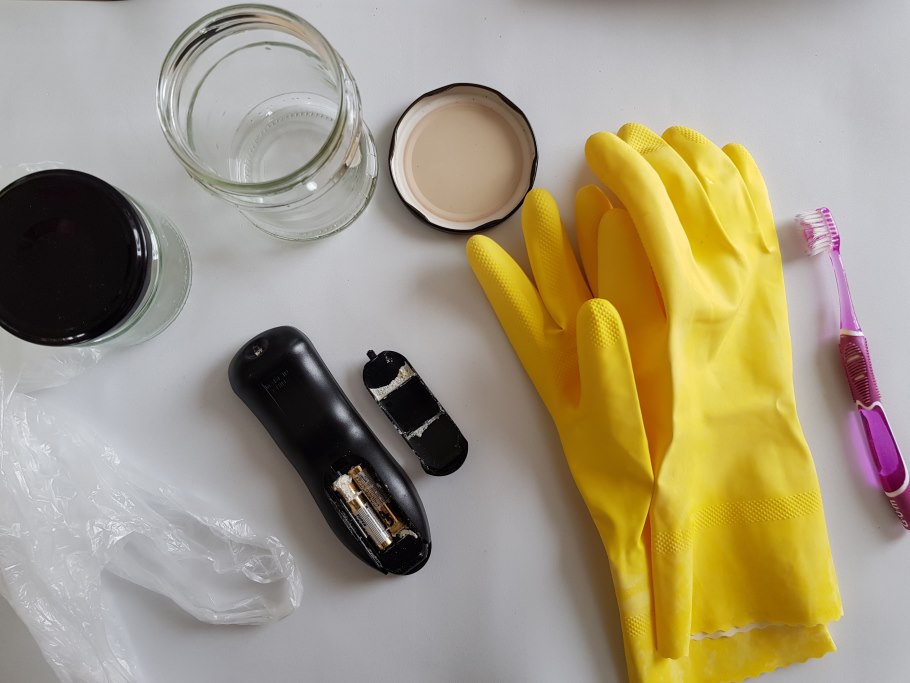
This is how the remote controller looks like after cleaning compared with the uncleaned image of the controller. The result of vinager and scrubbing with a toothbrush:
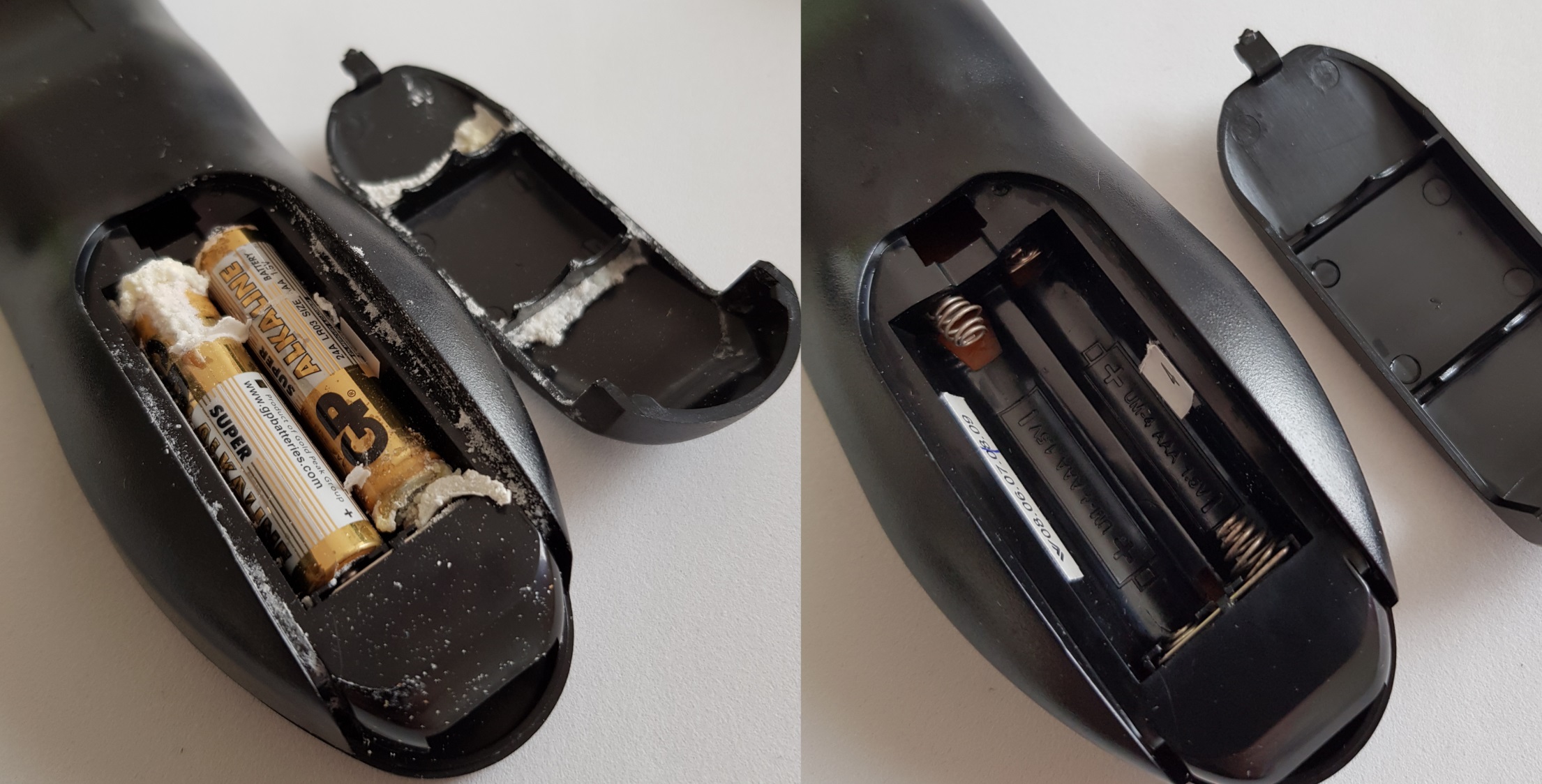
Let the device you cleaned dry for a long time before you try it with new batteries! To avoid any short-circuits.
Battery types
Alkaline batteries
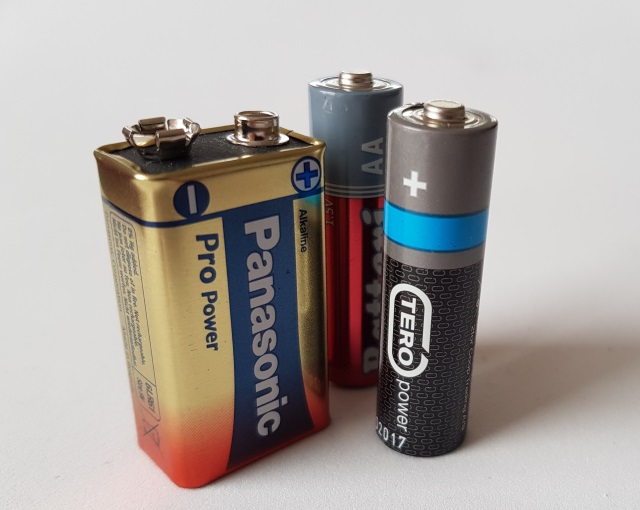
These ones often leak. Alkaline batteries are cheap to produce. They are very common in consumer products and are often preinstalled in toys etc. The acid in these batteries are of a basic solution. An acidic solution should be used to neutralise it and clean it up. Lemon juice or vinegar are ideal choices.
They often have a voltage that are multiplied by 1.5. Common voltage values are 1.5V and 9.0V.
Silver oxide batteries
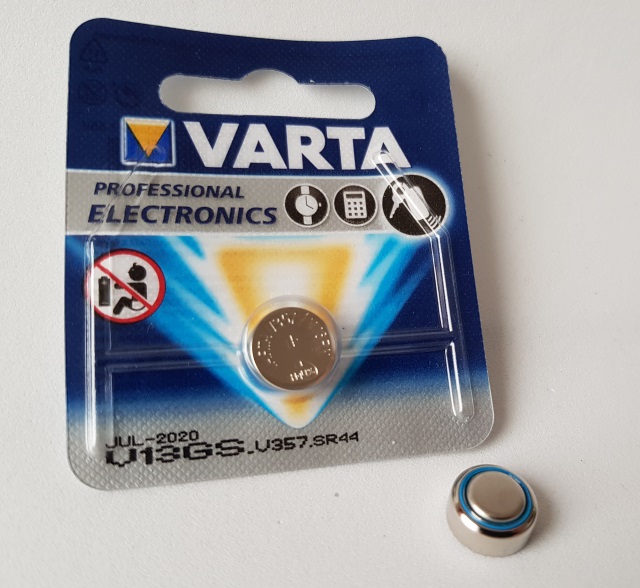
These kinds of batteries are often found in watches, toys, and calculators. They are called button cells or coin cells because of their shape. They can be confused with lithium batteries. Lithium batteries in the same shape often have a voltage of 3.0V and Silver oxide batteries often have a voltage of 1.55V. There is no information on the battery on the picture about it’s type or voltage. In such a case turn to the Internet and google whatever you can find on it.
I haven’t seen on the Internet what people are using to clean of the acid from them. But the Wikipedia article says that the electrolyte inside is alkaline based. In that case I presume an acidic solution like lemon juice or vinegar should do the trick.
Lithium Batteries
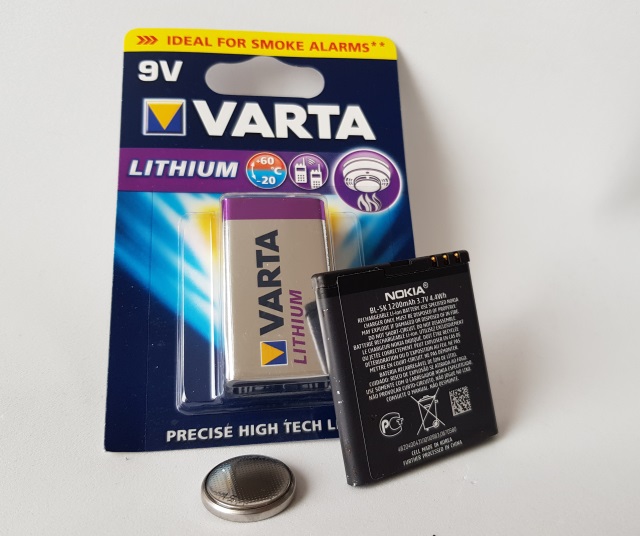
Never fool around with Lithium batteries! If you short-circuit a lithium battery it can catch fire or even explode! It has been recorded that even not damaged or short-circuited lithium batteries have caught fire. Probably due to flaw in the manufacturing. Physical damage and age can also make lithium batteries unreliable. I am sad to tell you this but if you have a lithium acid leakage you should throw away the device. In a container, glass or metal that can’t catch fire. Lithium batteries rarely leak acid but if they do the device itself might be damaged. Because, why would it leak in the first place? The acid can also catch fire by itself and you won’t be sure if you have cleaned everything away. If you decided to clean lithium battery acid use only water and a cotton rag.
Lithium batteries are often found in cell phones, computers, laptops, video game consoles etc. Lithium battery voltages can vary but are often written as multiples of 3 to 3.7. A lithium button cell battery is often 3V.
Nickel Cadmium Batteries
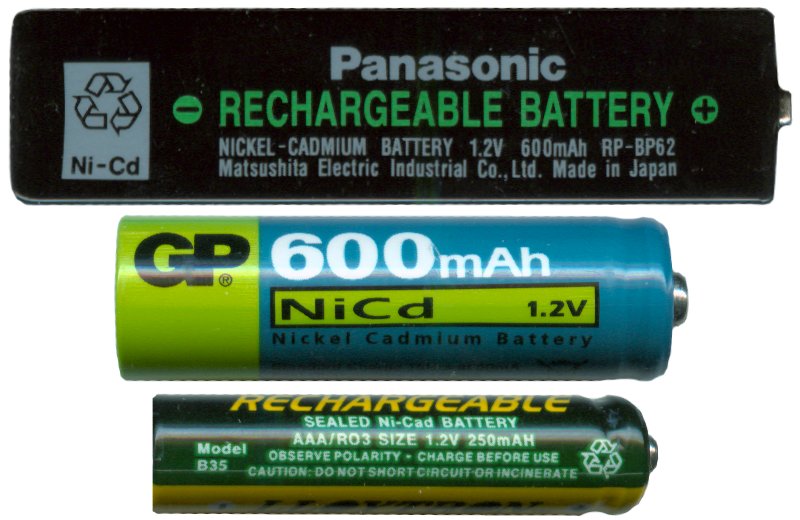
I couldn’t find any nickel cadmium batteries in my household, so I borrowed this picture from the Internet.
Nickel cadmium batteries are often rechargeable. They come in all kind of variations, but the voltage are often multiples 1.2V. The acid in Nickel cadmium batteries are extremely corrosive. It will eat through most materials, even metal. A reminder: Always use rubber/latex gloves and protection glasses. While handling with this kind of leakage I suggest covering all your face just in case.
To neutralize and clean this acid you need a base solution. Baking soda will do the thing.
Lead-acid batteries
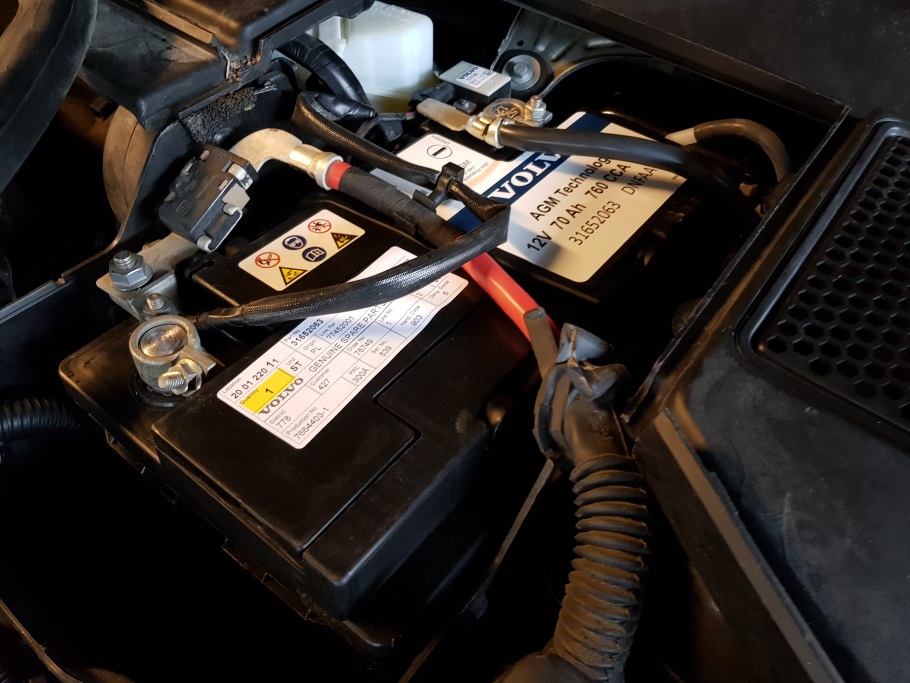
Dealing with electronics in your spare time you will rarely or never get in contact with this type. The only place in my home I could think about finding this one was in my car.
This type of battery is common in cars and industry. The voltage amount is often a multiplier by 2. The most common value is 12V. The safety and cleaning instructions are the same as for nickel cadmium batteries. The acid is corrosive! Use protective gloves and glasses and cover your face. Use baking soda to neutralize the acid.
Finally, I wish you good luck with the batteries in your household!
References
- https://www.consumerreports.org/batteries/whybatteriesleak/
- https://www.batteries.com/pages/coin-cell-button-cell-battery-guide
- https://www.wikihow.com/Clean-up-Battery-Acid-Spills
- https://en.wikipedia.org/wiki/Silver-oxide_battery
- https://cleaning.lovetoknow.com/How_to_Clean_Leaking_AA_Batteries
- Book. Make: Electronics Second Edition, Charles Platt. ISBN: 978-1-680-45026-2
2 Responses to “How to clean up battery acid leakage”
Robert Mullen
“The acid in these batteries are of a basic solution. An acidic solution should be used to neutralise it and clean it up. Lemon juice or vinegar are ideal choices.”
Oh, the irony…..
Alkaline batteries do not contain “acid”.
raspberryfield
Agree, thanks for pointing it out.
Sorry this is due to word-by-word translation from my native language. Commonly we just call everything inside batteries for “battery-acid” even in fact it does not contain acid….